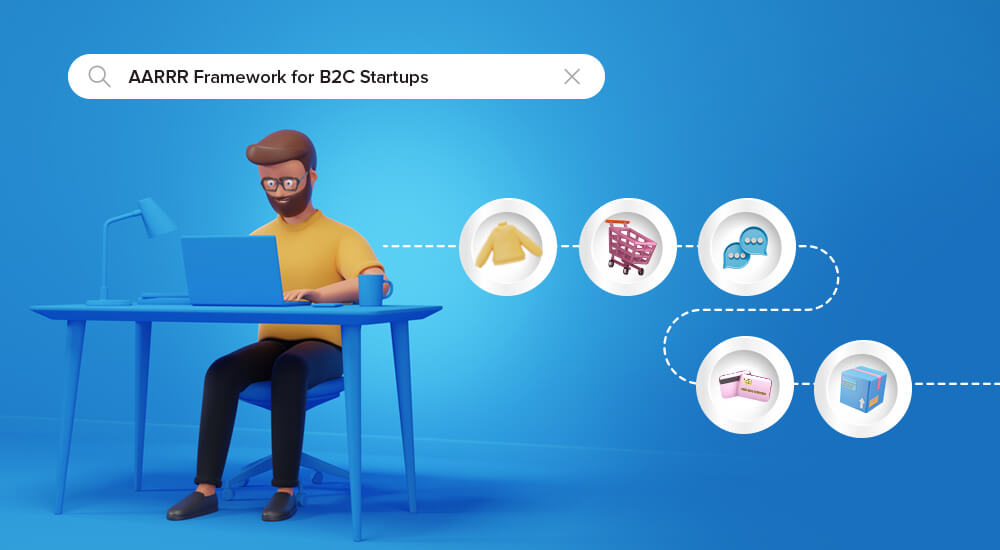Let's Talk
We would love to hear from you. Want to know more about our services or have any questions? Say Hi!
AARRR Framework for B2C Startups in the Digital Branding Agency Space

In the fast-paced business world, B2C Startups face numerous challenges when achieving sustainable growth. In order to effectively scale their operations and maximize their success, these startups require a well-defined framework that provides actionable insights into their performance metrics. Enter, the AARRR framework – a comprehensive model that empowers B2C Startups to drive growth and optimize their business strategies. In this article, we will delve into the purpose of the AARRR framework and explore how it can benefit business in the digital branding agency space.
What does AARRR stand for?
The AARRR metrics framework is a set of metrics that track user behavior as well as growth and success. They are straightforward while also measuring your company’s growth effectively. Because the acronym for the five different forms of measurement spells out AARRR, everyone’s favorite pirate noise, it is also known as “pirate metrics.”
The AARRR framework shows conversion, or the number of people moving from stage to stage, and metrics that are useful to analyze at a particular stage. It also shows the number of users at each stage of the funnel.
Dave McClure, Investor from Silicon Valley, observed at the conference that startups primarily or exclusively concentrate on social media likes, followers, or Google impressions. He, therefore, developed the pirate metrics to ensure that companies:
- Pay close attention to metrics that affect the company’s health directly.
- Find out what works for products and promotions using the right data.
Each letter stands for a particular funnel stage.
Five stages of the AARRR framework
Acquisition: Acquiring new clients is the first stage of the AARRR framework. This entails a range of marketing and advertising initiatives designed to reach and draw potential customers to the startup’s product or service. B2C startups can evaluate the success of their marketing campaigns and adjust their acquisition strategies by examining acquisition metrics like website traffic, click-through rates, and cost per acquisition (CPA).
Activation: The next goal is to activate new users by making sure they have a positive first experience with the product or service. Activation metrics, such as account registrations, app downloads, or initial product usage, gauge how much users interact with a startup’s offering. By analyzing activation metrics, startups can identify potential bottlenecks or areas for improvement in their user onboarding process.
Retention: After users are engaged, the emphasis shifts to keeping them around for the long haul. Retention metrics aid B2C startups in determining how well they are keeping customers and whether their offerings are satisfactory. Customer churn rate, user engagement, and repeat purchase rates are a few metrics that offer useful information about user satisfaction and loyalty. Startups can improve customer retention and create a devoted user base by addressing any problems that could cause customers to leave.
Revenue: The AARRR framework acknowledges that generating revenue is an important component of any business. Revenue metrics aid B2C startups in comprehending their pricing strategies, monetization plans, and overall financial standing. By analyzing metrics such as average revenue per user (ARPU), customer lifetime value (CLTV), and conversion rates, startups can optimize their revenue generation efforts and identify opportunities for growth.
Referral: The AARRR framework’s final stage focuses on using happy customers to generate referrals and organically grow the customer base. Referral metrics assess the success of customer advocacy and word-of-mouth advertising. Startups can maximize their growth potential by leveraging the network effect and the strength of positive customer experiences by rewarding referrals and tracking referral rates.
Why is AARRR Important?
Metrics are sufficiently transparent for the client flow when a project is launched, from attraction to interest and purchase. Just keep in mind that AARRR focuses on a quick and successful start rather than business development after the start. It enables you to concentrate on the key phases that your product goes through.
- Create your funnel and determine where users stall out the most.
- Improve customer conduct right away.
It functions flawlessly with new web services, applications, products, courses, and shops. It is appropriate for new products from businesses that up until now have only operated in the offline market as well as new apps that are extensions of well-established brands.
Let’s examine how the AARRR framework for B2C business
Strategic Focus: The AARRR framework offers startups a structured methodology that enables them to match growth strategies with particular goals at each stage. Startups can avoid a scattergun approach and more efficiently allocate their resources by concentrating on the key metrics within each stage.
Actionable Insights: The AARRR framework’s capacity to offer actionable insights into a startup’s performance is one of its main advantages. Startups can pinpoint areas for improvement, maximize their marketing initiatives, improve user experience, and hone their monetization strategies by routinely monitoring and analyzing relevant metrics.
Holistic View: The AARRR framework provides a holistic view of a startup’s growth trajectory, enabling entrepreneurs and digital branding agencies to assess the state of their company as a whole. Startups can identify potential holes or bottlenecks in their growth funnel and take proactive steps to address them by taking into account all five stages of the framework.
Scalability: As B2C startups work to expand their businesses, the purpose of AARRR framework is to track and control growth. Startups can identify scalable strategies, duplicate effective campaigns, and make sure that growth is long-term sustainable by methodically tracking the metrics at each stage.
For B2C startups operating in the digital branding agency space, the AARRR framework is a powerful tool for driving performance growth. By adopting this framework, startups can gain a strategic focus, derive actionable insights, and maintain a holistic view of their growth trajectory. In an ever-evolving market, the AARRR framework equips startups with the necessary tools to thrive, adapt, and scale their businesses effectively. Embrace the Pirate Metrics, and set sail towards sustainable success in the digital branding agency landscape.
If you are a brand and looking for an expert who can help you analyze your branding and AARRR framework, get in touch with us today.
Also Read:- Plan a successful social media B2C Marketing Strategy
Also Read:- Tips On How to Make B2C Marketing Social and Successful


